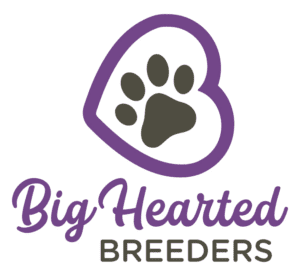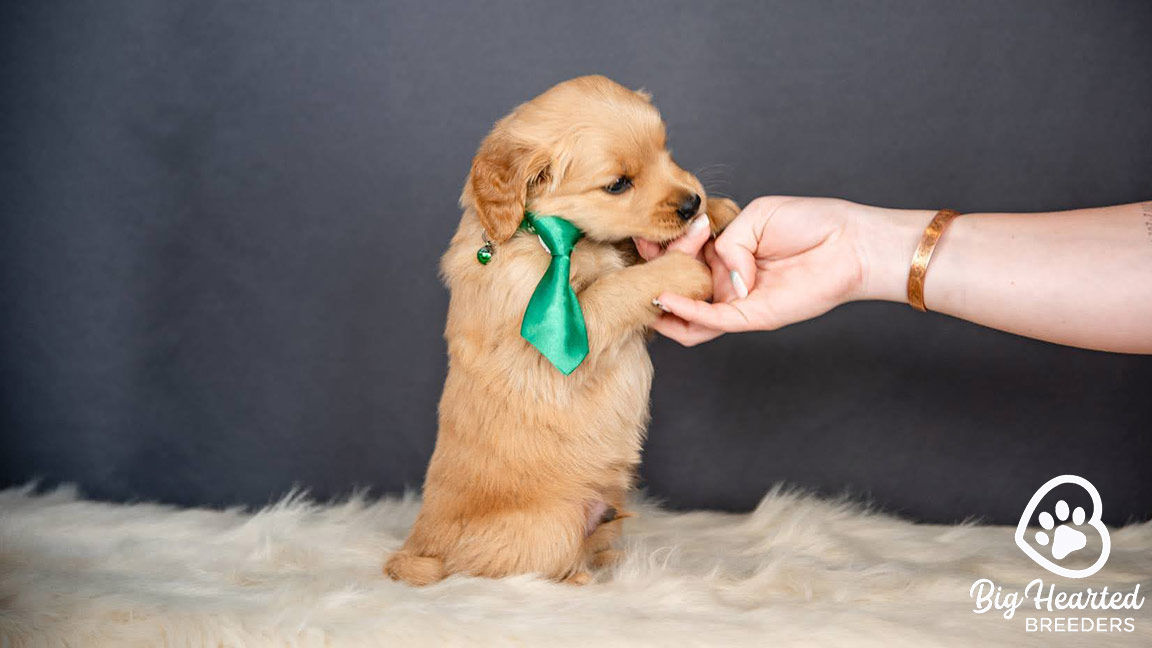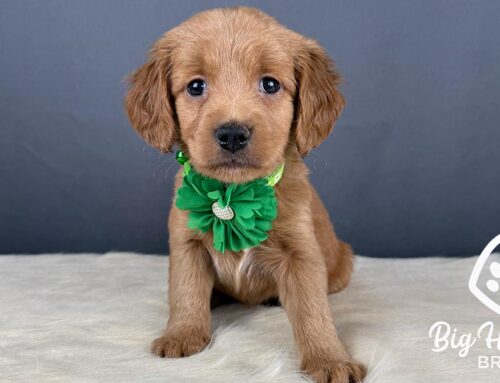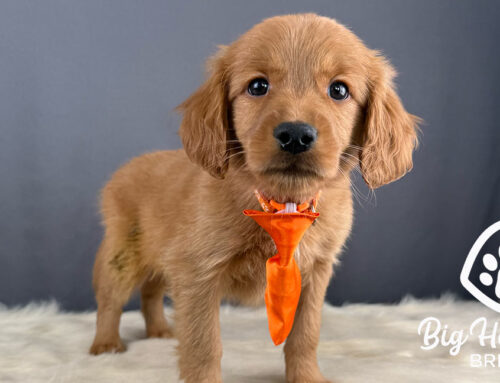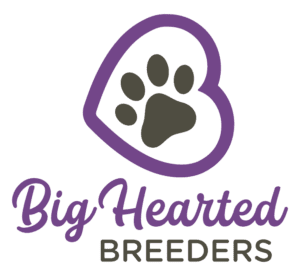Dog Body Language: What Your Pup’s Tail, Ears, and Eyes Are Saying
Dog Body Language: What Your Pup’s Tail, Ears, and Eyes Are Saying
Wouldn’t it be amazing if dogs could just tell us what they’re thinking? Imagine your pup walking up and saying, “I’m nervous about that thunderstorm,” or “I’d really like a belly rub right now.” The truth is, they already do, just not in words. Dogs communicate through their bodies, and once you learn how to read the signals, it feels like you’ve unlocked a secret language.
At Big Hearted Breeders, we love helping families understand their puppies beyond the wagging tails and cute faces. Getting familiar with dog body language can make training easier, prevent misunderstandings, and most importantly, strengthen the bond you share with your best friend.
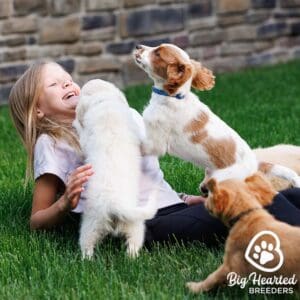
Why Dog Body Language Matters
Every wiggle, ear flick, or sideways glance carries meaning. Dogs rely on body language much more than vocal sounds. Yes, barking, whining, and growling play a role, but their real “conversations” happen silently. By tuning in, you’re able to respond to their needs, whether it’s offering comfort, giving space, or joining in on a game of fetch.
Reading dog body language also keeps everyone safe. A child who knows that a stiff body and tucked tail mean “back off” is less likely to get nipped. On the other hand, recognizing relaxed ears and soft eyes can help you approach a dog confidently when it is calm and happy.
Think of it this way: when you learn your dog’s nonverbal cues, you’re speaking their love language.
The Tail: A Built-in Mood Meter
The tail might be the most misunderstood part of dog body language. People often assume wagging always equals joy, but that’s not the whole story. Tails can reveal excitement, fear, caution, or even frustration.
- High, stiff wagging: Your dog is alert and possibly a little tense. It doesn’t always mean aggression, but it’s definitely not the same as a floppy, happy wag.
- Fast, loose wag with whole body wiggle: This is the classic “I’m so happy to see you!” signal. Puppies especially do the full-body wiggle of joy.
- Low or tucked tail: Often signals fear, uncertainty, or submission. It’s your pup’s way of saying they feel unsure and may need reassurance.
- Neutral wag at mid-height: Usually relaxed and comfortable, especially if combined with other soft signals like blinking eyes.
One tip: pay attention to context. A tail wag in the backyard while chasing a ball is very different from a tail wag at the vet’s office.
Ears: Radar Dishes with Emotions

Your pup’s ears are always working, picking up sounds you may not even notice. But beyond listening, their position tells you how your dog feels.
- Ears forward and perked: Curiosity, alertness, and interest. Your dog is tuned in to something, whether it’s a squirrel outside or the sound of food being poured.
- Ears pinned back: This can show fear, stress, or submission. Pair this with a tucked tail, and your dog is likely to be uncomfortable.
- Ears sideways or floppy: Relaxation, comfort, or sometimes playfulness.
For floppy-eared breeds like Miniature Golden Retrievers, the signals can be a little more subtle, as their soft ears naturally hang down. At Big Hearted Breeders, we encourage new owners to watch for those subtle shifts, such as ears moving slightly forward in curiosity or pinning back during moments of nervousness. Over time, you’ll get to know
The Eyes: Windows to the Doggy Soul
Dogs may not shed tears like we do, but their eyes are packed with expression. Learning how to read them is an essential part of understanding dog body language.
- Soft, blinking eyes: Content and relaxed. Dogs often do this when they’re resting next to their favorite person.
- Wide eyes showing the whites (whale eye): Anxiety, unease, or stress. This often appears when a dog feels trapped or uncomfortable.
- Direct, hard stare: Can indicate a challenge, guarding behavior, or a high level of focus. This is not the same as a soft gaze of affection.
- Slow blinks: Yes, cats do it, but dogs can too. It’s usually a sign of trust and calm.
Just like humans, every dog has slightly different eye expressions, but once you learn your pup’s “normal,” changes become easy to spot.

Putting the Puzzle Pieces Together
The secret to mastering dog body language is looking at the whole picture, not just one body part.
For example:
- Tail wag + perked ears + relaxed eyes = happy, curious dog
- Tucked tail + pinned ears + whale eye = scared or stressed dog
- Neutral tail + soft eyes + relaxed body = calm and comfortable dog
Dogs rarely give mixed signals; their whole body usually tells the same story if you look closely.
Common Situations and What They Mean
At the Dog Park
If your pup’s tail is wagging loosely, body is bouncy, and ears are perked, they’re ready for fun. But if they suddenly stiffen, freeze, or give another dog the whale eye, it might be time to step in before play gets too rough.

Meeting New People
Some dogs greet new humans with happy wiggles and eye contact. Others might back up, tuck their tails, and avoid looking. Both are normal, but recognizing hesitation helps you give your dog space to adjust.
At the Vet
Even the bravest doodle or retriever can get nervous on the exam table. Look for signs like lip licking, pinned ears, or tucked tails. Bringing treats and speaking calmly can help ease their stress.
Tips for Dog Owners
- Observe daily: The more you watch your dog in various situations, the better you’ll become at reading their behavior.
- Consider the whole dog: Don’t judge based on the tail alone: look at ears, eyes, body posture, and even their mouth.
- Use what you learn in training: If your pup shows stress, back off and try again later. If they’re relaxed, you’ve found the perfect moment to reinforce a behavior.
- Teach your kids: Show children the basics of dog body language so they know when a pup wants to play and when it needs space.
The Big Hearted Breeders Approach
At Big Hearted Breeders, we don’t just raise puppies, we raise family companions. That means helping each family understand how their new best friend communicates. We encourage new owners to watch for tail, ear, and eye signals from the very beginning. It creates trust, reduces stress, and makes training so much smoother.
When families visit our puppies, we love pointing out the little details. A relaxed pup lounging on the floor isn’t “lazy”, they’re showing comfort and trust. The bouncy puppy zooming around with ears flopping forward isn’t “hyper”, they’re expressing pure joy. Once you see the world through the lens of dog body language, you’ll never miss a beat.
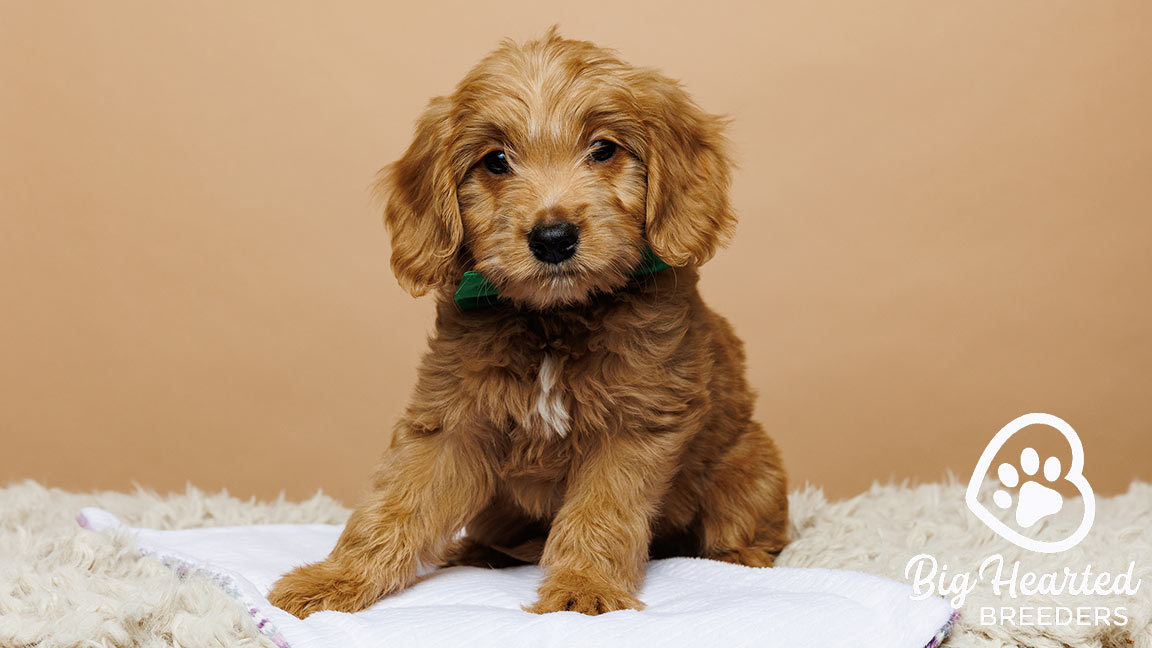
Final Thoughts
Your dog may not use words, but they are talking to you every single day. By learning the ins and outs of dog body language, you’re not just interpreting signals, you’re building a deeper bond. From tail wags to ear flicks and soft gazes, every gesture is a window into your pup’s world.
So next time your dog tilts their head, tucks their tail, or gazes at you with those soulful eyes, pause for a moment. They might just be saying more than you think.
Frequently Asked Questions
How can I tell if my dog is stressed?
Look for a combination of signals like pinned ears, tucked tail, whale eye, lip licking, or yawning outside of bedtime. These are common signs of stress in dog body language.
Why does my dog show the whites of their eyes?
This is called “whale eye” and usually means your pup feels uncomfortable or trapped. It’s a clear signal to give them space or change the situation.
Is a wagging tail always a good thing?
Not always. A loose, full-body wag means happiness, but a stiff, high wag can indicate alertness or tension. Always read the tail in context with the rest of the body.
What does it mean when my dog avoids eye contact?
Avoiding eye contact often means submission or nervousness. Some dogs also naturally prefer not to stare—it’s not always a bad sign, just part of their personality.
Can I use body language to train my dog?
Absolutely! Noticing when your pup is relaxed and ready to learn makes training more successful. You can also use your own calm, open body language to reassure them.
